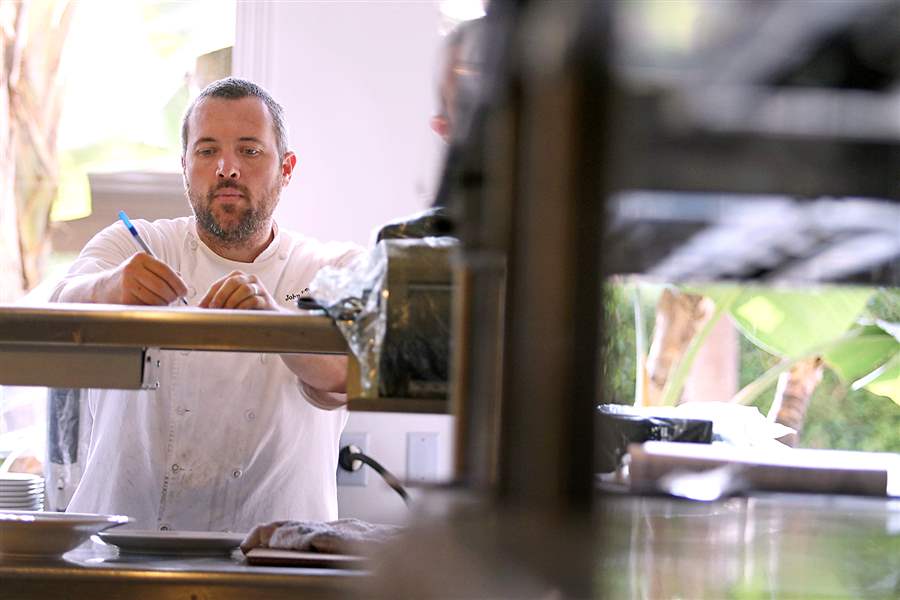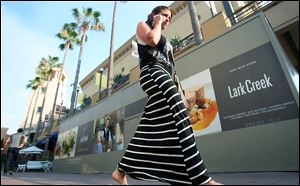
RETAILERS COUNT ON LURE OF FANCY MEALS
Fine-dining restaurants sating malls’ appetite for customers
Pricier, posher eateries gaining in favor over fast food
8/5/2013
Lark Creek executive chef John Ledbetter makes a final count on kitchenware at Fashion Island in Newport Beach, Calif. Lark Creek is one of several fine-dining restaurants at the upscale mall.
MCT

Lark Creek executive chef John Ledbetter makes a final count on kitchenware at Fashion Island in Newport Beach, Calif. Lark Creek is one of several fine-dining restaurants at the upscale mall.
The Fig & Olive restaurant chain drips with foodie cred.
The eateries, which started in Manhattan, feature fancy olive oils and celebrity sightings. An average diner’s check easily breaches $50. The Mediterranean-inspired cuisine is the antithesis of quick-stop mall chow.
But by November, a Fig & Olive will open in a 12,000-square-foot space at Fashion Island in Newport Beach, Calif., beating out 50 others for the prime spot away from the main shopping plaza.
It will offer ocean views, a garden with a fireplace, wine shelves and a white room inspired by the Cote d’Azur. Each of the 60 olive trees ringing the site costs $15,000, only a small part of the multimillion-dollar investment by the restaurant chain and the Irvine Co., which owns the property.
“The stigma of opening in a mall is going away,” Fig & Olive founder Laurent Halasz said of his first foray into a shopping center. “There’s been a huge change.”
U.S. shopping centers are moving from fast food to fancy food.
It started a few years ago as tired food courts started to transform into slick dining terraces. Now, upscale restaurants are even replacing department stores as mall anchors.
At Irvine Co. Retail Properties, which owns Fashion Island and Crystal Cove Shopping Center, also in Newport Beach, an increasing portion of mall revenue is from food. Two staffers are dedicated to finding dining tenants; two years ago, no one was.
“We view these restaurants as being traffic draws,” said Dan Sheridan, the firm’s president.
Drawing visitors has become a big concern for mall operators, who figure they need more than apparel and shoe stores and the occasional movie theater.
They’re battling growing online shopping options and free shipping offers. Plus, busier schedules have more consumers making purchases from the convenience of their phones and computers.

Shoppers exit to the parking lot as they pass by Lark Creek restaurant at Fashion Island in Newport Beach, Calif. Retailers view fine dining as something shoppers can’t get online but can if they go to the mall or shopping center. Industry data show mall restaurants outperforming fast-food sites.
At the same time, shopping-center owners are losing interest in multiunit budget eateries and are courting elite foodie favorites with the lure of prominent plots of land and consultations with top-level mall executives. They’re targeting the growing ranks of diners who shun cookie-cutter chain menus for meals they can brag about on blogs and social media.
Industry statistics show that restaurants at malls are outperforming those centers’ fast-food outlets. Sales at mall restaurants grew 4.3 percent in the year that ended in May, while mall fast-food purveyors posted a 0.3 percent drop, according to data from the International Council of Shopping Centers.
“The presence of food and beverage as a fresher, more upscale experience is only going to get bigger,” said architect Tim Magill, a partner at 5 Plus Design in Hollywood. “The ratio is tilting more in that direction than retail, especially as shopping centers have to offer something more that people can’t get online.”
The Irvine Spectrum shopping center in Irvine, Calif., closed its food court late last year and will add an Umami Burger next year. It also plans to sprinkle new culinary options such as Cucina Enoteca, Wood Ranch, and Tender Greens to pull foot traffic.
Medical transcriptionist Kelley Uyeda, 45, has managed to munch at every Irvine Spectrum restaurant, including organic eatery Paul Martin’s American Grill and vegan stop Veggie Grill. Compared with five years ago, she has more than doubled the amount of time she spends at the mall.
“I don’t go there for the shopping — it’s because they have some really great restaurants,” Ms. Uyeda of Foothill Ranch, Calif. said. “I’m more inclined to meet up with people there now.”
But malls should be careful about investing heavily in a food-centric floor plan, said Rachel Rosenberg, executive vice president of real estate broker RKF.
“It’s imperative that not only the tenant but the landlord consider the regionality — both the market and the consumer base — when putting together package deals,” she said. “For example, Darden [Restaurants Inc.’s] concept, Seasons 52, may be well suited for a cosmopolitan, upscale market, but may not translate to the consumer in less sophisticated locales.”